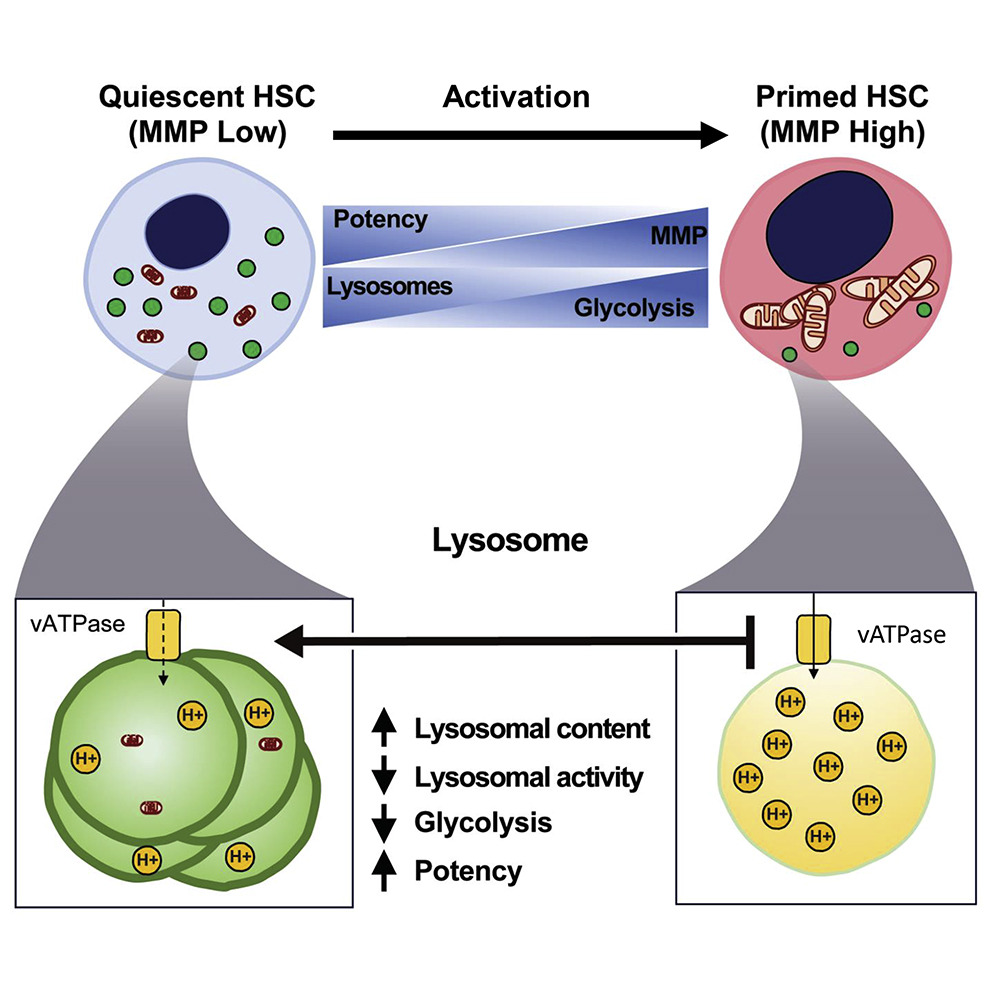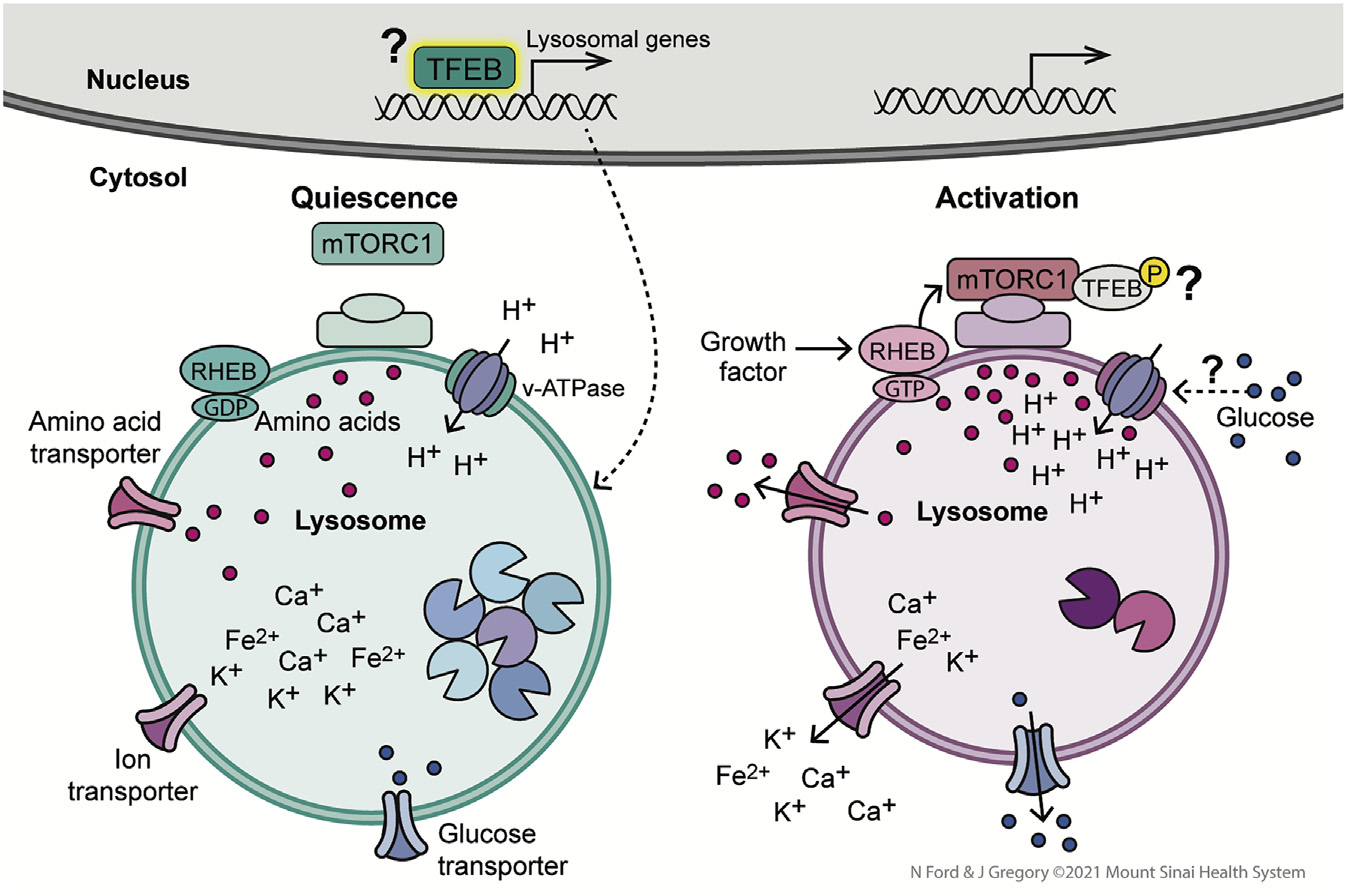CURRENT RESEARCH PROJECTS

Blood Stem Cells Hibernate via Lysosomes; Liang et al, Cell Stem Cell, 2020. Old yellow leaves in the Winter (the waste of hibernating quiescent blood-forming stem cells) are stored and recycled in the green bin (lysosomes) to produce the blooming tree in the Spring (primed active blood-forming stem cells). Illustrated by: Ni-Ka Ford, Katrina Kapp 2020.






Old Blood in a Young Body; Rimmelé et al, Stem Cell Reports, 2014. The effects of loss of SIRT1 on blood and blood stem cells in the young recapitulates the blood defects of the old. Illustrated by Nazanin Sarbandi 2014.

Foxo3 regulates erythroid cell maturation and enucleation.
Liang et al, PLoS Genetics 2015.
Hematopoietic Stem Cells and Their Organelles (Lysosomes, Mitochondria) Towards Improving Stem Cells’ Function, Health and Longevity
The very few hematopoietic stem cells (HSCs) in the bone marrow produce a massive, diverse and balanced blood; this production is tightly regulated to respond to daily needs, and to regenerate in response to injury or loss (as in hemorrhage) during the lifetime. The regulation of blood production is compromised with age. Disruption of this production may lead to disease. Ghaffari lab is identifying mechanisms that maintain HSC functions, and that are altered in disease, specifically in blood malignancies, and with age.
One such mechanism recently discovered in the lab is centered on lysosomes. Our current work is focused on the mechanistic understanding of how lysosomes, and their communication with mitochondria control HSCs and how the disruption in lysosomal-mediated pathways leads to blood malignancies specifically leukemias.
Our organelle (mitochondrial and lysosomal) studies of hematopoietic stem and progenitor cell activity (Yalcin et al., EMBO 2010; Rimmelé et al., Stem cell Reports, 2014; EMBO Reports, 2015; Liang et al., Cell Cycle 2016; Bigarella et al., JBC, 2017; Liang et al., Cell Stem Cell, 2020; Qiu et al., Blood Advances 2021; Ghaffari, Cell Stem Cell, 2021; Qiu et al., STAR Protocols, 2022) result from our initial identification of the longevity FOXO (FOXO3 in HSCs) transcription factors as key regulators of stem cell activity and the subsequent over a decade work towards elucidating their functions.
Our current work is partly focused on reversible mechanisms that promote leukemic stem cell formation. These mechanisms may also pertain to HSC aging (Arif, Qiu et al., in revision). The hope is that by decelerating the aging process of blood stem cells, age-related blood disorders may be delayed, or perhaps in some cases, prevented.
Leukemic Stem Cells and Their Organelles
In leukemia, leukemic stem cells (LSCs) are cells that resist therapy and reestablish leukemia in patients up to years after remission. Understanding the biology of leukemic stem cells may provide unique therapeutic opportunities. Our work indicates that deregulation of pathways that protect stem cells from age-associated cellular damages may intersect with pathways that promote leukemia (Bigarella et al., In Submission). We are currently testing this hypothesis in human HSCs and their leukemic [acute myeloid leukemia (AML) and myeloproliferative neoplasm (MPN)] counterparts (Qiu et al., Blood Advances, 2021).
Erythroid Cell Production and Mitochondria
Erythropoiesis is the process of making red blood cells (RBCs) from hematopoietic stem and progenitor cells. RBCs carry oxygen and travel throughout the body to oxygenate all tissues. Anemia or reduced capacity of RBCs to carry oxygen constitutes a major health problem associated with many disorders and with aging. In response to loss or reduced production of RBCs, blood-forming stem and progenitor cells are activated to produce RBCs.
Ghaffari lab identified FOXO3 as one of the main transcription factors that coordinates the maturation process of erythroid cells. FOXO3 was shown to mediate the expression of mitochondrial, metabolic and redox-related enzymes and regulates metabolism in maturing erythroid cells (Marinkovic et al., JCI, 2007; Yalcin et al., EMBOJ, 2010; Zhang et al., AJH 2014; Liang et al., PLoS Genetics, 2015). The positioning of mitochondria behind the nucleus was shown to be essential for erythroid enucleation (Liang et al., Blood Advances, 2021) and FOXO3 was found to be critical for both mitochondrial function and enucleation in late erythroid precursors (Liang et al., PLoS Genetics, 2015). Additional work found that FOXO3 and p21 mediate erythroid apoptosis in beta-thalassemia (Liang, Lin et al., Blood Advances, 2023). Currently the lab is focused on identifying specific mitochondrial functions that control erythroid cell production (Menon and Ghaffari, Exp. Hem, 2021; Liang et al. Blood Adv., 2021). Our goal is to contribute to advancing the knowledge necessary for improving the therapy outcome in erythroid disorders.
